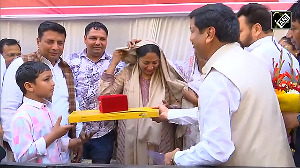I attended CommunicAsia in Singapore in mid-June. The focus of the conference was the twin themes of mobility and broadband. What follows are some of my impressions about the emerging communications landscape and the implications for India.
The conference sessions were focused on the telecom scenario in Asia. They provided a fascinating glimpse of the region -- with different countries at different stages in the evolution of their communications and services infrastructure. The leaders are undoubtedly Japan and South Korea, while China and India offer the biggest opportunities.
Taiwan and Singapore are racing ahead to deploy broadband, 3G and wireless LANs. Hong Kong has the best IP-TV service. An interesting fact: last year, nearly a million new mobile users were added -- every day. The world now has 1.8 billion mobile users.
Two words that were heard a lot at the conference were "convergence" and "ecosystem." Convergence is finally becoming a reality as next-generation networks with all-IP cores are making it possible to have triple play (voice, data and video) services flow over the same network.
There will be a time soon when our handsets will support WiFi and GSM/CDMA, such that in hotspots mobile phone service subscribers will use WiFi to make and receive calls, while at other locations they will use the cellular networks.
No single company has all the answers and there is a web of relationships to deliver valuable services to consumers and enterprises. Operators control the networks (and the customer relationships), but they need a combination of cheaper access devices and compelling services to drive traffic and revenues. An ecosystem approach is about creating win-win scenarios for the entire value chain.
The three panel discussions identified the hot issues: content, 3G and VoIP. The biggest success stories in mobile value added services have been unexpected -- SMS, ringtones and, increasingly, ringback tones. But there are still plenty of opportunities in the content space to deliver useful services to consumers on their always-on, always-available, always-connected, personal devices and over broadband networks.
Operators have begun 3G rollouts across the region -- but there is no clear business plan on how money will be made. WiMax looms as a possible threat -- or opportunity. VoIP is hot and happening -- it is clear that voice will just be another application on the IP network.
The vision for the future is simple, seamless and personal communications -- from wireline and wireless networks. Tomorrow's world will be one where users will be able to communicate any time, any where from the device of their choice.
Users will be able to define their own experiences and the network will become more intelligent to bring highly personalised services to users. All of this will bring about a significant lifestyle change for consumers and also enable the real-time enterprise.
The dream of this world of seamless mobility has been there for many years. But the work that has been happening in the background is now making it all possible. Parallel trends in digitisation are making a huge array of content available to us on any of the screens -- the TV, the PC or the mobile.
The focal point is now shifting from the network to the user. What people really want is to be connected, informed, entertained and all in their own way. Whether one is at home or work, commuting or in public places, the networks will connect us to friends, family, colleagues at work and to our business information.
As Peter Vesterbacka, founder of HP Mobile E-Services Bazaar, puts it: "All people are mobile, even when they work. They have needs all the time, either private or professional. They need access to services and information all the time, wherever they are. The devices they will use to access these services can be wired or wireless -- the people are mobile Mobility is a natural state of being, not a niche market. The internet is a subset of the mobile market."
For us in India, we have a very good mobile infrastructure. What is needed is for the operators to alter their mindsets and open up their walled gardens to third-party content and applications developers -- much like the way NTT Docomo did with i-mode in Japan when it launched in 1999. More than voice and person-to-person SMS, future growth will come from an array of lifestyle and business services -- and for that the need is to build an ecosystem.
The broadband situation in India is nothing short of a disaster. While countries like South Korea, Japan and Hong Kong talk of multi-megabit connectivity, we are stuck in the kilobit world.
India needs cheap, reliable, high-speed, ubiquitous broadband access -- for homes and businesses. (Anyone who thinks 256 Kbps at Rs 350 per month with download caps is "broadband" should visit one of our Asian counterparts.)
This will spur our content and software developers to innovate and build services for the domestic market -- and potentially extend them to others globally. South Korea did that very well -- and the result is not just companies like LG and Samsung but also online gaming innovators like NCSoft. India has the creative talent in both story-telling (Bollywood) and software. The combination is what can help build next-generation killer services.
The scale of India's developmental challenge needs big, bold decisions. Technology can play a small but critical part in this process. State-of-the-art mobile and broadband networks can help India address the challenges of education, health and governance. Removing obstacles to building them should be a national priority. l
The author is Managing Director of Netcore Solutions Pvt Ltd.






 © 2025
© 2025